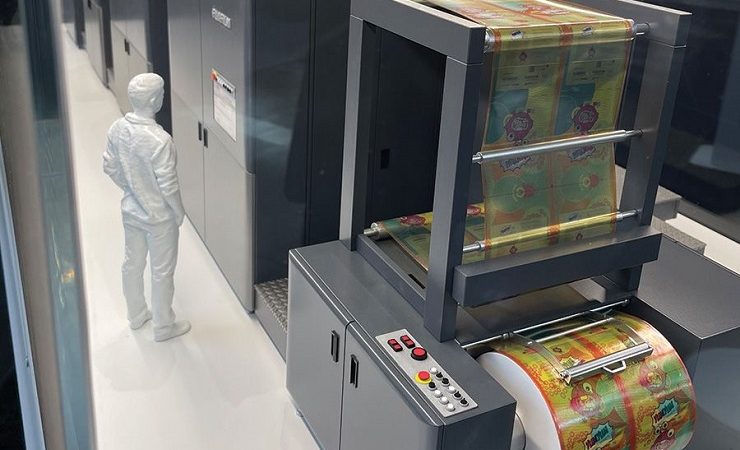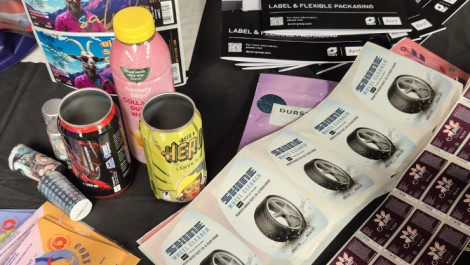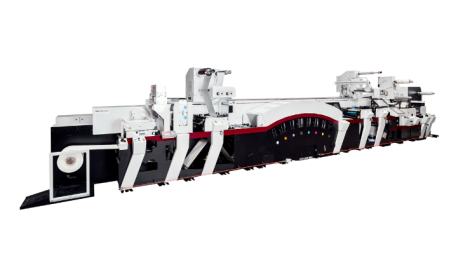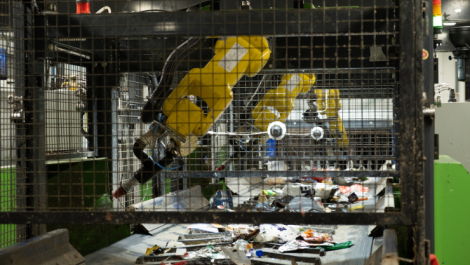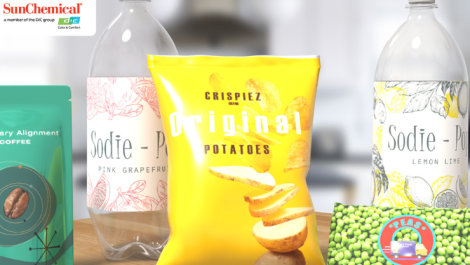interpack isn’t a print industry trade show. With a focus on processing and packaging, the expo largely serves those brands and producers looking to upgrade and enhance their manufacturing of food, beverages, confectionery, bakery, pharmaceuticals, cosmetics and non-food items.
This doesn’t stop the print industry from having a presence, however. For packaging manufacturers offering printing and converting, such as Graphic Packaging International and WestRock, having a presence at the show works as they seek to capitalise on the high presence of attendees from further up the supply chain at which to target their services and solutions.
Print’s presence
The presence of suppliers at the show was largely via those offering coding and marking options. Domino, Kortho, Leibinger, Markem-Imaje, Videojet, etc.
Domino for example, had a large stand outlining its full portfolio of coding and marking options. From its K-series monochrome inkjet systems were K300 and K600G, whilst thermal transfer overprinting and laser coding were amongst the other technologies also on show. These were presented in various configurations for different applications to highlight both the efficiency and productivity available through modern[1]day coding and marking technology, using different technologies to apply legible and variable data at high speeds to primary and secondary packaging and products directly. Moreover, they showed how such technology can be utilised by companies on their journey to net zero by targeting zero coding errors, reducing product waste to zero, having zero unplanned downtime and requiring zero capital commitment. This also hinged on production optimisation, targeting waste reduction throughout the process and prioritising energy efficiency.
An example of this has been the work of baby care products manufacturer Hello Bello. The brand uses a Domino Ax350i continuous inkjet printer to code individual nappies with MEK-free ink. This code is composed of a lot number, line number and individual product number to allow each nappy to be assigned to the correct multipack bag and shipment box. Additional Ax350i printers then apply aggregated codes onto each multipack. M230i-TB print and apply labellers are used to apply universal product codes to multipacks and boxes, which are used for worldwide tracking of items shipped to retail stores. Cx350i secondary packaging printers, equipped with dual printheads, print A-grade barcodes with vegetable oil-based ink on both sides of the outer corrugated boxes.
Using these technologies has allowed Hello Bello to reduce rework and downtime, whilst also delivering worldwide traceability, from production and shipping through to the retail store right through to the baby’s bottom.
Steven Holmes, vice president of technical services at Hello Bello, said, ‘A lot of people think that a nappy is a really simple item for a baby, but it is really not. These bags have different functions, different forms and different counts. We code each nappy and each bag with a Domino ink coder running every day at 800 nappies a minute. Without this code, we would have a tremendous amount of rework and downtime.’
Kurz subsidiary MPrint highlighted the MJETeco, a standalone UV inkjet product for late-stage customisation. It can handle a wide variety of projects, from printing barcodes or serial numbers for security labels, to complete back labels for wine and spirits. German printer Achertäler Druckerei signed up for one of these machines to respond to new EU regulations for wine labelling. This requires extensive, additional information to be included on wine labels sold in the EU from 8 December 2023.
A new compact four-colour system based on the company’s Monojet technology was also shown. Whilst Monojet can be specified as a four-colour system, the compact footprint of the demo system makes it more suited to integration into existing equipment lines. This will make the integration of full-colour printing a more realistic prospect in the future, as noted by MPrint sales director Achim Herzog, whilst presenting new opportunities in the future to develop one-step packaging production processes.
‘This will increase flexibility, reduce waste and make production more sustainable,’ opines Mr Herzog.
Full-colour printing was further presented by the likes of Gallus and AstroNova, which presented T3-OPX for full-colour and durable overprinting directly onto materials with ink-receptive surfaces. From Gallus was ‘One’, an inkjet-based digital label press with a compact footprint and high-level automation. This press was introduced last year to ‘drive digital transformation’ in the supply chain, with a clear focus on total cost of ownership.
David Stark, who heads up Gallus sales in the south of Germany at parent company Heidelberg, noted that there had been lots of interest in digital, from both brands and converters attending interpack 2023. ‘Specifically, they are very interested in low migration technologies that we can offer. This is of high importance to the industry and drove a lot of interest.’
eProductivity Software (ePS) had its software for the packaging and corrugated industries front and centre. This included Radius ERP, PrintFlow 4D, AutoCount 4D and eFlow Automator, each designed to optimise production processes and increase efficiency. In the case of Radius, this ERP has been designed for the labelling, folding carton and flexible packaging markets, to offer tools that help companies manage their production processes from start to finish. This includes estimating, quoting, production planning, scheduling, raw materials, finished goods and waste management. The software also features advanced reporting and analytics tools that provide real-time insights into production performance, enabling companies to make data-driven decisions and optimise their processes. For Sietse Jansen, EMEA packaging industry specialist, such technology dovetailed with packaging representing the lion’s share of interest on the ePS stand during the show, with interest particularly high from those involved in pharmaceuticals and flexibles.
‘It’s been a very international show, with both brands and converters wanting to know about and understand how technologies such as ours will shape the future of processing and packaging.’
Star of the show
For Screen and Fujifilm, interpack provided a perfect opportunity to push on with their work to make industrial digital flexible packaging a reality. In the case of Screen, samples produced using its Truepress Pac 830F and 520P water-based inkjet digital flexible packaging presses lined the walls of its booth. Such high-quality digitally printed samples ‘caught the eye’, according to Juan Cano, as did Screen’s capability with inkjet white that allows such print to be produced. Mr Cano, recently promoted to the role of marketing director at Screen Europe, notes that these were shown to target the technology at the profile of attendee at the show. ‘Industrial digital flexible packaging is going to be driven by the strategic need to offer it, so it is important to reach decision makers at both brands and converters. This show gave us the perfect opportunity to do this, as well as present advances we have made with this technology as the first presses get set to enter the market.’
Also moving towards market adoption is Fujifilm with FP790. A scale model of this machine was on show alongside the technologies of partner companies Hybrid Software, Henkel and Nordmeccanica. These partnerships have been forged to create an ecosystem that will allow FP790, and digital flexible packaging more generally, to be adopted at scale. As Manuel Schrutt, head of packaging in the EMEA region at Fujifilm, comments, ‘Integration into existing production environments is essential to the growth of this market. The potential market is huge and there is an appetite for this technology. We are at a tipping point for digital flexible packaging, and machines likes FP790 will tip the balance. It has been the standout of the show.’
His colleague Will Hearn, UK national sales manager, reiterates this by noting the level of interest seen at interpack 2023 in the FP790. ‘It has been extraordinary and exceeded our expectations, which only goes to highlight that the industry is ready for industrial digital flexible packaging.’

